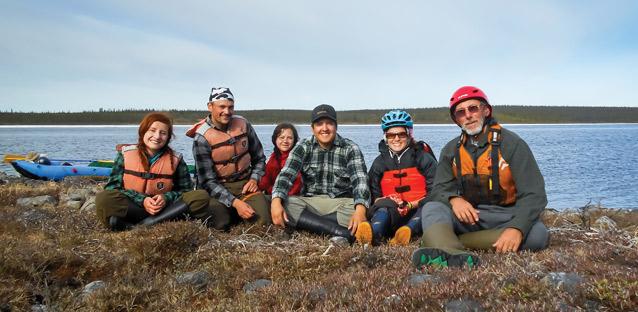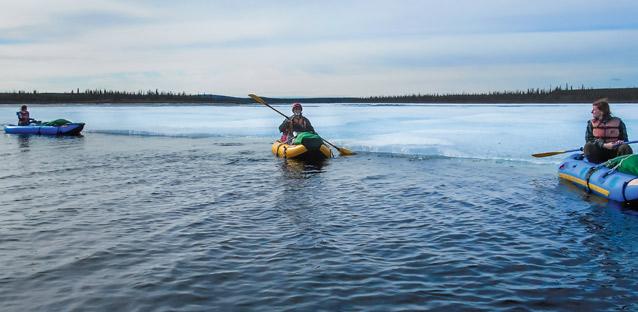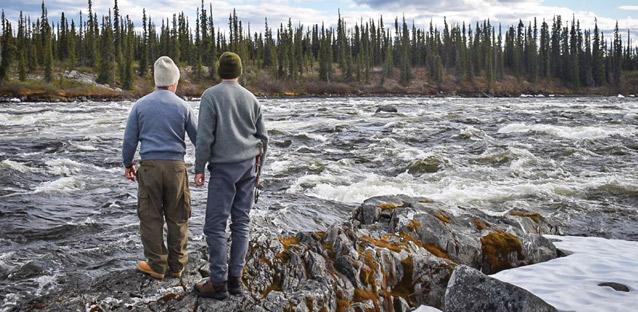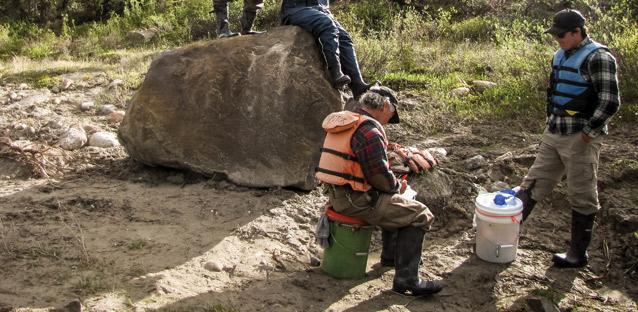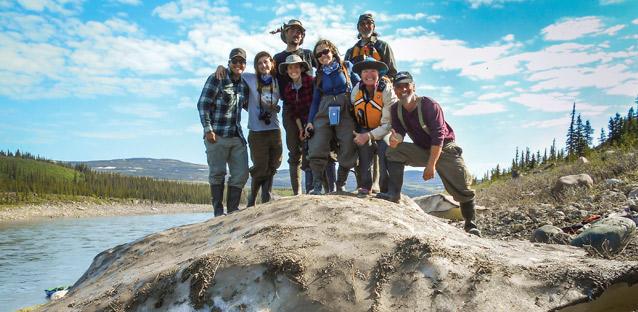Professor Jimmy Dunn and a crew of five students head north for summer research and discovery
By Jaquelyn Zubrzycki
Life above the Arctic Circle isn’t always as cold as you would expect. After a six-week kayak trip through the Canadian Arctic this summer, Jane Allen, a senior at UNC, can attest to that.
“The day we crossed into the Arctic Circle, I was wearing a tank top,” she says.
During the short nights’ few hours of darkness, Allen felt a chill in her tent. Otherwise, the temperatures were in the mild 40s, 50s and even 60s.
Allen was one of five UNC students who joined James “Jimmy” Dunn, a professor and chair of the department of Geography and Geographic Information Sciences (GIS), along a 290-mile river trip on Canada’s Coppermine River, during which they conducted research about how a changing climate is affecting spruce trees. Their findings: Spruce trees in this region are beginning to grow farther north than in the past, aided by temperatures that are, on average, getting warmer.
The students were following a route Dunn traveled 40 years ago. Notes from the previous trip allowed the students to compare data from 1977 to what they found on their trip this summer.
The group experienced a wild and inspiring landscape and pushed their bodies to their
physical limits, sometimes covering as many as 40 miles in a day. Now that they’ve
returned, they will visit schools around Colorado in hopes of sharing the importance
and excitement of exploring and studying geography.
A shifting tree line
In Colorado, the tree line is often discussed in terms of altitude. At above 11,000 feet, the average temperature in July is below 50 degrees Fahrenheit and trees don’t grow. In the Arctic, the mean temperature is also below 50 degrees. As you head north, trees become sparse, and those that are growing are thinner and shorter.
Dunn predicted that, as global temperatures have risen, trees would be growing farther north than before and would be producing viable seeds and seedlings.
“If the world’s climate is changing, and the far north is predicted to be warmer than ever before, we should see plants responding,” Dunn says. And the Arctic’s temperature has been increasing, according to a number of sources — including the Danish Meteorological Group, which has been tracking temperatures above 80 degrees latitude for more than 50 years.
In a cold environment, spruce trees survive by forming genetically identical clones. The clones form in clusters, which can survive for hundreds of years.
But in warmer temperatures, new, genetically distinct seedlings are able to form. The seedlings grow farther away from their parent trees and stand as single trees.
On this summer’s trip, Dunn and the students observed spruce and also collected spruce cones from different latitudes. The students kept journals of their observations and compared them to Dunn’s notes from the 1977 trip.
The group found that spruce trees do seem to be responding to a warmer climate: Spruce seedlings were growing 70 miles north of where they were spotted 40 years ago, with some seedlings even growing north of the Arctic Circle. The group also brought seeds back to Colorado to study whether they are viable, which would provide more evidence that spruce are responding to a warmer environment.
Dunn says the findings from this trip are preliminary, and that there is a need for more study of changing tree lines in the Arctic.
Pristine landscapes
The trip started in Yellowknife, on Great Slave Lake in northern Canada, and ended at an Inuit village called Kugluktuk. The trip took the group from a boreal forest into arctic tundra, and eventually to the Arctic Ocean. They departed on June 12 and returned on July 2.
A lot has changed since 1977: Dunn’s first trip was before GPS and cell phones. “We were navigating with these old-fashioned things called maps,” Dunn says.
Even with changes in technology and a trip leader who has now journeyed down arctic rivers more than a dozen times, preparations for this summer’s trip took nearly two years. The group — Dunn, Don Cleason, Denise Rettedal, Emily Doerner, Rusbel Contreras Jr., Gretl Galgon, Léo Sinigaglia and Allen — sewed packs and skirts for their boats. They gathered enough food to provide 4,000 calories a day for each paddler.
All that preparation allowed them to witness an environment many people never experience: wolves, swans, musk ox and grizzly bears. Fields of wild berries. Water so clean it can be consumed without filtration.
“The amount of ice you’d see melting and breaking off and falling into the water was
truly amazing,” Allen says. “It changed my perspective.”
Bringing it home
Now that they have returned from their trip, the students will serve as “ambassadors of geography” in Colorado high schools. Each student will give 10 talks, during which they’ll share photos from their trip and information about the research they conducted.
Dunn’s hope is that hearing from college students will spark the teens’ interest. He says many young people perceive geography to be a dead subject — memorizing capitals and the names of places — and that K-12 schools too often reinforce that idea.
“It’s relevant and vibrant,” he says, and the career prospects are good. Geographers can help places prepare for floods or work with government agencies around the world.
Allen agrees. “Having high school students see people who are in their college years being able to go out and do these things … will really get them excited to pursue geography.”
For Allen and Dunn, river trips like this summer’s have inspired a deep desire to explore and study. Dunn says that he is already planning two trips next year to study invasive species along Colorado rivers.
“I don’t think there’s a more profound way to learn than to do something like this,” Dunn says. He hopes UNC increasingly embraces experiential learning.
Allen, too, has caught the exploring bug. “It made me really interested in research and field work, and I fell in love with kayaking. … it was by far one of the coolest things I’ve ever done,” she says. “It was terrifying but also liberating.”

